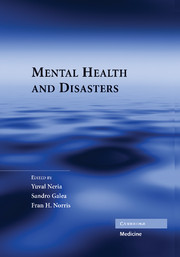29 results
The Geography of Mental Health and General Wellness in Galveston Bay After Hurricane Ike: A Spatial Epidemiologic Study With Longitudinal Data
-
- Journal:
- Disaster Medicine and Public Health Preparedness / Volume 10 / Issue 2 / April 2016
- Published online by Cambridge University Press:
- 28 January 2016, pp. 261-273
-
- Article
- Export citation
Disaster Mental Health Services Following The 1995 Oklahoma City Bombing: Modifying Approaches to Address Terrorism
-
- Journal:
- CNS Spectrums / Volume 7 / Issue 8 / August 2002
- Published online by Cambridge University Press:
- 07 November 2014, pp. 575-579
-
- Article
- Export citation
Mental Health Care for Ethnic Minority Individuals and Communities in the Aftermath of Disasters and Mass Violence
-
- Journal:
- CNS Spectrums / Volume 10 / Issue 2 / February 2005
- Published online by Cambridge University Press:
- 07 November 2014, pp. 132-140
-
- Article
- Export citation
Framework for Research on Children's Reactions to Disasters and Terrorist Events
-
- Journal:
- Prehospital and Disaster Medicine / Volume 27 / Issue 6 / December 2012
- Published online by Cambridge University Press:
- 04 October 2012, pp. 567-576
- Print publication:
- December 2012
-
- Article
- Export citation
Diagnostic utility and factor structure of the PTSD Checklist in older adults
-
- Journal:
- International Psychogeriatrics / Volume 24 / Issue 10 / October 2012
- Published online by Cambridge University Press:
- 30 May 2012, pp. 1684-1696
-
- Article
- Export citation
11 - Community resilience: concepts, assessment, and implications for intervention
- from Section 3 - Resilience in families, communities, and societies
-
-
- Book:
- Resilience and Mental Health
- Published online:
- 07 September 2011
- Print publication:
- 18 August 2011, pp 162-175
-
- Chapter
- Export citation
3 - The Experience of Disaster:
- from Part One - Concepts
-
-
- Book:
- Mental Health and Disasters
- Published online:
- 07 May 2010
- Print publication:
- 20 July 2009, pp 29-44
-
- Chapter
- Export citation
Part One - Concepts
-
- Book:
- Mental Health and Disasters
- Published online:
- 07 May 2010
- Print publication:
- 20 July 2009, pp 5-44
-
- Chapter
- Export citation
Mental Health and Disasters - Half title page
-
- Book:
- Mental Health and Disasters
- Published online:
- 07 May 2010
- Print publication:
- 20 July 2009, pp i-i
-
- Chapter
- Export citation
Part Six - Case Studies
-
- Book:
- Mental Health and Disasters
- Published online:
- 07 May 2010
- Print publication:
- 20 July 2009, pp 385-576
-
- Chapter
- Export citation
Mental Health and Disasters - Title page
-
-
- Book:
- Mental Health and Disasters
- Published online:
- 07 May 2010
- Print publication:
- 20 July 2009, pp iii-iii
-
- Chapter
- Export citation

Mental Health and Disasters
-
- Published online:
- 07 May 2010
- Print publication:
- 20 July 2009
Acknowledgments
-
- Book:
- Mental Health and Disasters
- Published online:
- 07 May 2010
- Print publication:
- 20 July 2009, pp ix-x
-
- Chapter
- Export citation
1 - Disaster Mental Health Research:
-
-
- Book:
- Mental Health and Disasters
- Published online:
- 07 May 2010
- Print publication:
- 20 July 2009, pp 1-4
-
- Chapter
- Export citation
11 - Distinctions that Matter:
- from Part Three - Vulnerability And Resilience
-
-
- Book:
- Mental Health and Disasters
- Published online:
- 07 May 2010
- Print publication:
- 20 July 2009, pp 175-200
-
- Chapter
- Export citation
Contents
-
- Book:
- Mental Health and Disasters
- Published online:
- 07 May 2010
- Print publication:
- 20 July 2009, pp v-viii
-
- Chapter
- Export citation
Part Four - Special Groups
-
- Book:
- Mental Health and Disasters
- Published online:
- 07 May 2010
- Print publication:
- 20 July 2009, pp 201-318
-
- Chapter
- Export citation
Contributors
-
-
- Book:
- Mental Health and Disasters
- Published online:
- 07 May 2010
- Print publication:
- 20 July 2009, pp xi-xvi
-
- Chapter
- Export citation
Part Seven - Questions and Directions
-
- Book:
- Mental Health and Disasters
- Published online:
- 07 May 2010
- Print publication:
- 20 July 2009, pp 577-610
-
- Chapter
- Export citation
Part Five - Interventions And Health Services
-
- Book:
- Mental Health and Disasters
- Published online:
- 07 May 2010
- Print publication:
- 20 July 2009, pp 319-384
-
- Chapter
- Export citation



